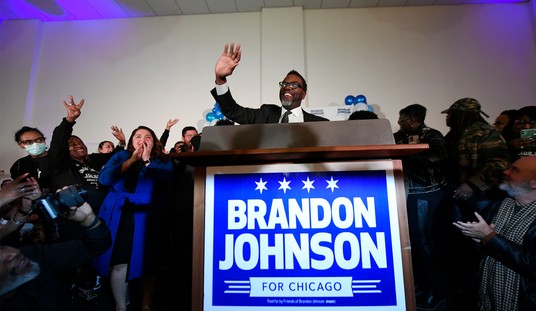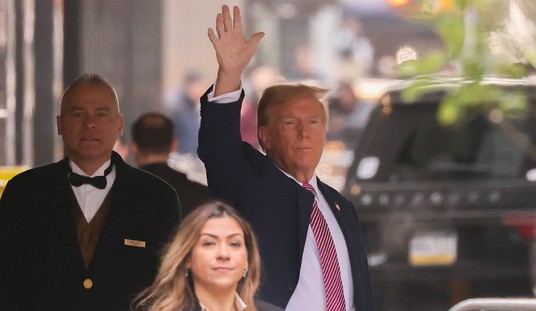Roger Simon comments on the Edwards/National Enquirer affair. Roger writes:
Some cheap psychoanalysis. I would guess that Edwards, like many cheaters, wanted to be caught. After all, it is hard to conceive he would be that dumb as to conduct a tryst in this modern/post-Bill Clinton era in, of all places, the Beverly Hilton. The Hilton — where such events as the Pre-Oscar luncheon and Arnold Schwarzenegger’s recent victory celebration are held — would be among the last places you would choose. It’s often a virtual den of paparazzi with staff and others always standing by to tip the gossip press on the latest celeb sighting. There are thousands of places in Southern California more low key for such a meeting. If Edwards is indeed that dumb, we are certainly lucky he never became President. Among those who should be scratching their heads at this moment are his supporters.
It’s safe to say that on any given hour, dozens of couples are having assignations in a variety of places. Some may have even been checking into the Beverly Hilton at the same time as John Edwards. Why was the Edwards affair news while the others just part of the background noise of life in a big city? Probably because the National Enquirer reporter threatened to introduce two entities to each other which when brought into contact would produce mutual annihilation. There were two Edwardses. One consisted of the legend whose image was carefully burnished in the press and the other was John Edwards the man, no better and no worse than most of us. And just as matter and anti-matter have to be kept apart in order to prevent both from canceling each other out in a burst of energy, so did the Edwards and anti-Edwards need to remain separate in order for both to survive. Both could not coexist in the same space of public perception.
The irony is that the John Edwards legend and all of its props were created by artful manipulation of the media. Nobody objected to that. But when the National Enquirer threatened to introduce the legend to its opposite there was a hue and cry about their lack of professionalism, etc. It may be pertinent to point out the Enquirer’s offense wasn’t entirely against the privacy of three people. Their real crime was to threaten to expose the facade built up with the help of parts of the press itself; to destroy the accepted narrative with an inconvenient fact. The news wasn’t that two people were having an affair at the Beverly Hilton; the real headline was that a carefully contrived myth was in danger of being exploded. In the movie The Man Who Shot Liberty Valance there is this exchange between a politician and a reporter:
Ransom Stoddard: You’re not going to use the story, Mr. Scott?
Maxwell Scott: No, sir. This is the West, sir. When the legend becomes fact, print the legend.
The modern version of this adage might be ‘when we’ve made up the legend don’t bother with the facts.’ Mickey Kaus writes “in a move that has apparently stirred up some internal discontent, the Los Angeles Times has banned its bloggers , including political bloggers, from mentioning the Edwards … story. Even bloggers who want to mention the story in order to make a skeptical we-don’t-trust-the-Enquirer point are forbidden from doing so. Kausfiles has obtained a copy of the email Times bloggers received from editor Tony Pierce.”
The problems with legends is that their continued existence requires maintenance. One example of the dead weight of maintaining a legendarium was illustrated by the recent primary campaign between Hillary Clinton and Barack Obama. It was remarkable to see pundits smashing the very same Hillary legend which they had been constructing only months before. One legend had to be replaced with another, the facts as unimportant in the latter as they were in the former. Another more recent example has been the public coverage of the Surge, condemned as “doomed” until it became convenient to advocate a precipitate withdrawal in the face of success; now the success of the Surge itself makes an arbitrary withdrawal viable because ‘we cannot lose the war’.
Andrew Klavan’s wonderful opinion piece in the Wall Street Journal observes that some public myths are so entrenched they can only be challenged indirectly, like the political struggles in Mao’s China named after flowers, numbers and colors. Myths are carefully confronted in code until it safe to challenge them directly. Klavan writes:
A cry for help goes out from a city beleaguered by violence and fear: A beam of light flashed into the night sky, the dark symbol of a bat projected onto the surface of the racing clouds … oh, wait a minute. That’s not a bat, actually. In fact, when you trace the outline with your finger, it looks kind of like . . . a “W.”
There seems to me no question that the Batman film “The Dark Knight,” currently breaking every box office record in history, is at some level … a conservative movie about the war on terror. … Batman is vilified and despised for confronting terrorists in the only terms they understand. Like W, Batman sometimes has to push the boundaries of civil rights to deal with an emergency, certain that he will re-establish those boundaries when the emergency is past. … And like another such film, last year’s “300,” “The Dark Knight” is making a fortune depicting the values and necessities that the Bush administration cannot seem to articulate for beans.
Conversely, time after time, left-wing films about the war on terror — films like “In The Valley of Elah,” “Rendition” and “Redacted” — which preach moral equivalence and advocate surrender, that disrespect the military and their mission, that seem unable to distinguish the difference between America and Islamo-fascism, have bombed more spectacularly than Operation Shock and Awe. Why is it then that left-wingers feel free to make their films direct and realistic, whereas Hollywood conservatives have to put on a mask in order to speak what they know to be the truth? Why is it, indeed, that the conservative values that power our defense — values like morality, faith, self-sacrifice and the nobility of fighting for the right — only appear in fantasy or comic-inspired films like “300,” “Lord of the Rings,” “Narnia,” “Spiderman 3” and now “The Dark Knight”?
The moment filmmakers take on the problem of Islamic terrorism in realistic films, suddenly those values vanish. The good guys become indistinguishable from the bad guys, and we end up denigrating the very heroes who defend us. Why should this be?
Because it cannot be otherwise, unless you are willing to disregard a memo from your editor and endure the ostracism of your friends. The emergence of legends in press coverage is equivalent to the phenomenon of “open secrets” within organizations. “Open secrets” are things everyone knows to be true (or false) when the opposite is publicly claimed. This corrupts the public debate. There is a need to demote the collection of media myths to the less exalted status of currently accepted hypothesis. Ironically, this may be in the process of being achieved through the establishment of other channels of reportage and fact-finding. The emergence of articles of faith (such as Anthropogenic Global Warming) create a serious stickiness in the way we view reality. The real problem with “printing the legend” is that we print the lie we are prepared to believe. In the end reality sets us straight and the adjustment is often painful.









Join the conversation as a VIP Member